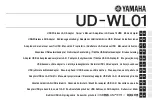
Reproduction of part or all of the contents of this document in any form is expressly prohibited other than for individual use only. All text, images and labels are property of nimax Gmbh.
Instruction Manual
Congratulations on the purchase of Omegon® variable
projection and focal adapter 1.25”. Also known as tele-
extender, it is used for afocal photography with an
eyepiece and a camera.
1. How does it work? A 1.25” eyepiece – with a
maximum of body diameter of 38m - is inserted
(eyepiece lens facing out) in the system through the
aperture on the back (#5 – figure 1). Then it slides all the
way in so that it is fixed by the Eyepiece fixation
thumbscrew (#6 – figure 1). Usually one wants to start
using an eyepiece of high focal length (say 25mm). The
camera can be attached to the T-Threads (#5 – figure 1)
if it has T-Threads (M42x0.75).
In theory, any camera with T-Threads or with a T-ring
can be used for projection photography. The
performance depends on the combination of distance
between the eyepiece and camera sensor, eyepiece
optical design and camera sensor (size).
2.1. Attaching the tele-extender to the telescope. The
assembled system (as decribed in 1) should now be
attached to a telescope. There are two options. If the
telescope’s focuser has T-Threads we suggest removing
the 1.25” nosepiece from the telextender and directly
attach it to the telescope. It provides more stability. If
the telescope focuser, on the other hand, only accepts
1.25” eyepiece barrels use the supplied 1.25” nosepiece.
2.2. Focusing. Before using the tele-extender make sure
to first focus the eyepiece. This gives you a rough focus
oint when using the tele-extender.
2.3. Focusing with the camera. Release the two
Extender fixing rings (#3 – figure 1). So that the T-
threads body (#4 – figure 1) slides freely in and out. Slide
all the way in so that the camera is at its closest position
to the eyepiece. Now start by racking in (or out) the
focuser to get a sharp image (focused) as seen by the
camera screen. The light from the eyepiece is being
projected to the camera. Depending on the camera’s
sensor distance to the eyepiece so is magnification
different.
3.1. Magnification and how it works. Using a long focal
length eyepiece provides less magnification than using a
short one. The longest the distance between the camera
and the eyepiece the biggest the magnification.
3.2. Illuminated Field. Camera sensors vary in size.
Photography using eyepiece projection usual deliver an
illuminated circle with the image and the surrounding
image is rendered black. This effect is technically
impossible to solve. The performance however is very
good for planets and the Moon. Therefor we
recommend testing several setups with different
eyepieces and distances to find the best setup.
DSLR Cameras usually use bayonet systems that
allow to change objectives. Remove the objective
from the camera and attached a compatible T-ring
(list of compatibility at the end of this document) –
not supplied.
Figure 1. Features.
1- Nosepiece adapter 1.25”;
2- Eyepiece body;
3- Extender fixing thumbscrews;
4- T-Thread body;
5- T-Threads;
6- Eyepiece fixation thumbscrew.
Figure 2.
A – Camera (DSLR);
B – T adapter;
C – Eyepiece;
D – Tele-extender.
Figure 3. Eyepiece is fixed inside the tele-extender.




















